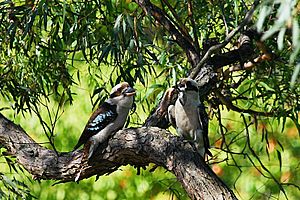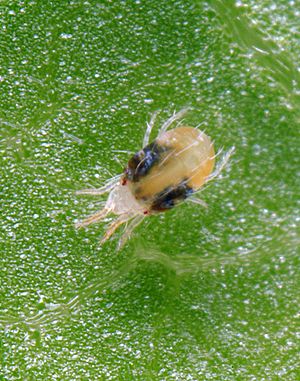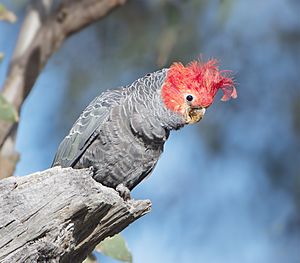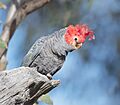Fauna of the Australian Capital Territory facts for kids
The Australian Capital Territory (ACT) is home to many amazing animals! You can find all sorts of creatures here, from tiny insects to large kangaroos. Let's explore the different animal groups that live in the ACT.
Contents
Cool Crustaceans of the ACT
The ACT's rivers are home to five types of freshwater crayfish. One of these is the Murray crayfish. It has a spiny body and two big white claws. Male crayfish have bigger claws than females. Females have a wider tail section. This crayfish can grow up to 150 mm long. You can find them in the Murrumbidgee River, Cotter River, and Paddys Rivers. Sadly, they have disappeared from the Molonglo River due to too much fishing and pollution.
Another red crayfish, Euastacus nobilis crassus, lives in the swamps of Mount Franklin and Mount Gingera. A tiny crayfish, Engaeus parvulus, is only 5 cm long. It builds a dirt mound around its burrow. This burrow has a large underground room with its own pool of water.
Small pools also hold tiny creatures like Daphnia, copepods, and ostracods.
Land-Dwelling Slaters
Slaters, also known as woodlice, are land crustaceans. The Armadillidium vulgare is common in gardens. It is metallic grey and can roll into a perfect ball when scared. Other types like Porcellio scaber and Porcellio laevis have also arrived in Canberra gardens.
Amazing Insects in the ACT
The ACT has over 200 kinds of insects, but we are still learning about many of them.
Famous Bogong Moths
The most famous insect is the Bogong moth. These moths spend their summers resting in the Brindabella Ranges when it's hot. They fly through the ACT in October and March. Bright city lights attract huge numbers of them, which can sometimes be a bit annoying! Long ago, Aboriginal people would visit the mountains in summer to eat these fat-rich moths.
Grasshoppers and Other Ground Dwellers
There are 47 types of grasshoppers in the ACT. Bermius brachycerus lives in reed beds near streams. Urnisa guttulosa prefers dry sand banks next to the Murrumbidgee River. Some special insects are in danger. These include the flightless Perunga grasshopper, Keys matchstick grasshopper, and the golden sun moth. Heterojapyx evansi is a very old type of insect. It lives in leaf litter in mountain forests.
Termites: Tiny Wood Eaters
Sixteen kinds of termites live in the ACT. Nasutitermes exitiosus builds mounds in eucalypt woodlands. Coptotermes lacteus builds mounds with clay walls. Coptotermes frenchi lives inside living trees. These wood-eating termites can also damage wooden buildings. A grass-eating termite, Amitermes neogermanus, lives underground.
Ladybirds and Beetles
Three types of ladybirds live around Canberra. Chaetolotis amy is a shiny black beetle with a blue-green shimmer. Its naming rights were auctioned off to help victims of the Canberra bushfires of 2003. The tortoise beetle Paropsis atomaria loves to eat Eucalyptus leaves.
Pests and Introduced Insects
Some insects brought from other places have become pests. The green vegetable bug is shield-shaped and attacks tomatoes and beans. Green caterpillars of cabbage white butterflies eat leafy greens. The codling moth caterpillar eats apples and pears. European earwigs munch on leaves and petals. Fermentation flies like rotting fruit. The Queensland fruit fly can be active in late summer. It eats apples, stone fruit, and vegetables.
Mealybugs are covered in white, powdery hairs. They suck sap from many plants, especially indoor ones. Scale insects also suck sap. They are still and covered by a flat disk. The black scale is a common problem. It makes a sticky white substance that can grow black mold and attract ants. The San Jose scale is a tiny grey dot that harms trees. Plague thrips feed in flowers, making petals turn brown. The greenhouse whitefly is a small aphid with white wings. It attacks weeds and broadleaf vegetables. The European wasp has arrived in the ACT in recent years.
Not all introduced insects are pests. Honeybees, dung beetles, and parasitic wasps are helpful. However, honeybees can sometimes become a nuisance, and wild swarms can be found.
Native Butterflies
The caterpillars of a native butterfly, the citrus butterfly, eat citrus leaves. The adult butterflies are large and have colorful wings.
The CSIRO has its insect division in Canberra. They have a huge collection of insects there.
Creepy Crawly Arachnids
Some arachnids, like the red spider mite, were introduced and are now pests. They suck sap from plants. People are trying to control them using another type of mite. The redback spider and white-tailed spider are spiders that some people are afraid of.
Scorpions found in the ACT include Cercophonius squama, Lychas marmoreus (little marbled scorpion), Lychas variatus (marbled scorpion), Urodacus manicatus (black rock scorpion), and Urodacus yaschenkoi (inland robust scorpion).
Worms in the Soil
Many different types of earthworms have been found in the ACT. Some common ones include Aporrectodea caliginosa, Aporrectodea trapezoides, Eisenia fetida, Eisenia (=Aporrectodea) rosea, and Lumbricus rubellus.
Molluscs: Snails and Slugs
The freshwater clam Corbicula australis lives in the ACT's rivers. Many land snails are also found here. These include Oxychilus draparnaudi (Draparnaud's glass snail) and Oxychilus alliarius (garlic glass-snail). The Cornu aspersum (garden snail) is a common garden pest in Canberra.
Freshwater snails like Physa acuta are found at Point Hut Crossing. Glyptophysa gibbosa lives in the Cotter River.
Slugs in the ACT include the Helicarion mastersi (royal semi-slug), Deroceras reticulatum (grey field slug), and Lehmannia nyctelia (striped field slug).
Fish of the ACT Rivers
Many native fish species have been pushed out of ACT rivers by introduced fish. These introduced fish include carp, brown trout, rainbow trout, redfin perch, mosquitofish, and dojo loach. Fishing is popular in the ACT. Many of these fish have spread because people illegally released them or used them as live bait.
Native Fish Species
Well-known native fish include the Murray cod and golden perch. Other less common native fish are the two-spined blackfish, found in the Cotter area. The trout cod disappeared locally but is being brought back. The silver perch is almost gone from the area. The Macquarie perch is endangered but still lives in the Cotter River. The mountain Galaxias is a small fish that is becoming rare. It is now only found in small streams where there are no trout.
Amphibians: Frogs of the ACT
In the dry woodlands and forests, the most common frogs are the pobblebonk and common eastern froglet. At higher, wetter places, Bibron's toadlet is more common. The brown tree frog can also be found.
The northern corroboree frog is very rare. It has amazing yellow and black stripes. A special program is trying to save it from disappearing forever. It lives in high, boggy areas in the ACT and New South Wales.
Reptiles: Snakes and Lizards
The most common snake in the ACT is the brown snake. The red-bellied black snake lives near rivers and can swim well. Snakes in the Gudgenby River sometimes do not have a red belly. Three other snakes are sometimes seen in the ACT: the Australian copperhead, tiger snake, and death adder.
Lizards of the ACT
Lizards in the ACT include the bearded dragon, mountain dragon, and the blue-tongue. The Australian water dragon can grow up to a meter long! The eastern stone gecko lives under rocks in the highlands. Goannas are rare. So are the striped legless lizard (found in grassy areas), the pink-tailed worm-lizard, and the grassland earless dragon.
Birds of the ACT Skies
Over 290 types of birds have been seen in the ACT. The gang-gang cockatoo is the bird symbol of the ACT. Some birds fly through the ACT on their migrations. Others live and breed here all year. The common myna was brought here on purpose. It is now a pest that lives all over the city.
Mammals: Furry Friends of the ACT
The mammals in the ACT are similar to those found along Australia's southern coast.
Monotremes: Egg-Laying Mammals
The short-beaked echidna can be found all over the territory. The platypus lives in pools in the rivers.
Marsupials: Pouch Animals
The tiger quoll is very rare. The eastern grey kangaroo has the largest numbers in the ACT's grasslands. It is the animal most often hit by cars on the roads. The swamp wallaby is common in the ranges and in lowland areas with shrubs. The brush-tailed rock-wallaby was last seen in 1959 and is now thought to be extinct. Wallaroos are spreading through the mountains and lowlands.
The common brushtail possum is common in cities, even with many foxes around. But it is only common in bushland where foxes are controlled. The common ringtail possum is rare. The sugar glider lives in forests and woodlands. The greater glider lives in higher, wetter forests. The common wombat lives in the high country and along river banks. It comes out of its burrow at dusk. Koalas are rare in the ACT, with the last sighting in the 1990s.
Placental Mammals: Diverse Creatures
More than half of the native mammals are placental mammals. Most of these are bats, with at least 18 different kinds. The most common bats are microbat species. This includes Gould's wattled bat, often seen in urban areas in the early evening. The white-striped free-tailed bat makes a sound that you can hear on summer nights. Other bats like the chocolate wattled bat, little forest bat, and large forest bat live in forests and woodlands.
There are two types of large bats called megabats. The grey-headed flying fox has visited the ACT regularly since 2003. The little red flying fox visits sometimes. The rakali, or water rat, lives in streams. The smoky mouse is a rare rodent. The dingo was hunted a lot when Europeans first arrived, but it still lives in the ACT.
Feral and Introduced Mammals
Mammals brought from other places have become pests. Besides introduced rodents, there are also wild cats. Rabbits used to be a big problem, but their numbers have gone down. This is thanks to control methods like destroying their burrows and spreading a rabbit disease. Foxes are hunted to reduce their numbers in rural areas.
Wild horses, called brumbies, live in the Namadgi National Park and nearby Kosciuszko National Park. Even though they harm the environment, people in the ACT have opposed killing them. Wild pigs live in the mountains and damage plants. They are controlled by hunting and poisoning. Fallow deer and wild goats are found in small numbers. Wild dogs can breed with dingos, which threatens the dingo population. Both are trapped and hunted near farms to protect sheep.
Images for kids







